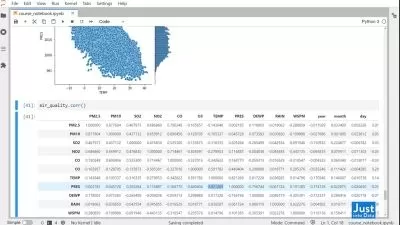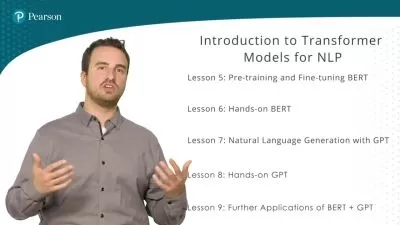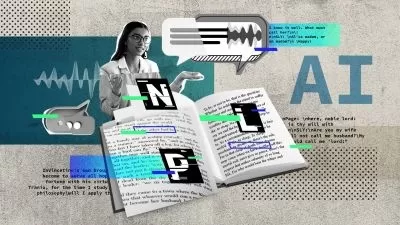Introduction to Natural Language Processing in Python [2024]
Hoang Quy La
14:08:31
Description
pandas, numpy, seaborn, matplotlib, spaCy, Stop-word removal, Case folding, XGBOOST, TextBlob, Hierarchical Clustering
What You'll Learn?
- pandas
- numpy
- seaborn
- matplotlib
- spaCy
- lemmatization
- tokenization
- Stop-word removal
- Case folding
- N-grams
- XGBOOST
- Word2vec
- skip-gram
- Bag of words
- Zipf’s law
- TF-IDF
- Feature engineering
- WordCloud
- Hierarchical Clustering
- Sampling
- Removing Correlated features
- Dimensionality reduction
- Tree methods
- TextBlob
- keras
Who is this for?
What You Need to Know?
More details
DescriptionNatural Language Processing (NLP) is a rapidly evolving field at the intersection of linguistics, computer science, and artificial intelligence. This course provides a comprehensive introduction to NLP using the Python programming language, covering fundamental concepts, techniques, and tools for analyzing and processing human language data.
Throughout the course, students will learn how to leverage Python libraries such as NLTK (Natural Language Toolkit), spaCy, and scikit-learn to perform various NLP tasks, including tokenization, stemming, lemmatization, part-of-speech tagging, named entity recognition, sentiment analysis, text classification, and language modeling.
The course begins with an overview of basic NLP concepts and techniques, including text preprocessing, feature extraction, and vectorization. Students will learn how to clean and preprocess text data, convert text into numerical representations suitable for machine learning models, and visualize textual data using techniques such as word clouds and frequency distributions.
Next, the course covers more advanced topics in NLP, including syntactic and semantic analysis, grammar parsing, and word embeddings. Students will explore techniques for analyzing the structure and meaning of sentences and documents, including dependency parsing, constituency parsing, and semantic role labeling.
The course also introduces students to practical applications of NLP in various domains, such as information retrieval, question answering, machine translation, and chatbot development. Students will learn how to build and evaluate NLP models using real-world datasets and evaluate their performance using appropriate metrics and techniques.
By the end of the course, students will have a solid understanding of the fundamental principles and techniques of NLP and the ability to apply them to solve real-world problems using Python. Whether you are a beginner or an experienced Python programmer, this course will provide you with the knowledge and skills you need to start working with natural language data and build intelligent NLP applications.
Course Outline:
Introduction
Course strucure
How to make out of this course
Overview of natural language processing
Text pre-processing
Tokenization techniques (word-level, sentence-level) and its implementation
Regular expression and its implementation
Treebank tokenizer and its implementation
TweetTokenizer and its implementation
Stemming and its implementation
WordNet Lemmatizer and its implementation
spacy Lemmatizer and its implementation
The introduction and implementation of stop word removal
The introduction and implementation of Case folding
Introduction and implementation of N-grams
Text Representation
Introduction to Word2vec and implementation
skip-gram implementation
Bag of word implementation
How to perform basic feature extraction methods
What are types of data
Text cleaning and tokenization practice.
How to perform text tokenization using keras and TextBlob
Singularizing and pluralizing words and language translation
What does feature extraction mean in natural language processing
Implementation of feature extraction in natural language processing.
Introduction to Zipf's Law and implementation
Introduction to TF-IDF and implementation
feature engineering
Introduction to WordCloud and its implementation
spaCy overview and implementation
Introduction to spaCy
Tokenization Implementation
lemmatization Implementation
Text Classifier Implementation
Introduction to Machine learning
Introduction to Hierarchical Clustering and implementation
introduction to K-means Clustering and implementation
Introduction to Text Classification and implementation
introduction to tree methods and implementation
introduction to Removing Correlated Features and implementation
introduction to Dimensionality Reduction and implementation
Mode of Instruction:
The course will be delivered through a combination of lectures, demonstrations, hands-on exercises, and project work.
Students will have access to online resources, including lecture slides, code examples, and additional reading materials.
Instructor-led sessions will be supplemented with self-paced learning modules and group discussions.
certification:
Upon successful completion of the course, students will receive a certificate of completion, indicating their proficiency in natural language processing with Python.
Join us on a journey into the fascinating world of natural language processing and discover the endless possibilities for building intelligent applications that can understand and interact with human language data. Enroll now and take the first step towards mastering the art of NLP with Python!
Who this course is for:
- Anyone interested in Artificial Intelligence, Machine Learning or Deep Learning
- Any data analysts who want to level up in Machine Learning, Deep Learning and Artificial Intelligence.
- Any people who are not that comfortable with coding but who are interested in Machine Learning, Deep Learning, Artificial Intelligence and want to apply it easily on datasets.
- Data Scientists who want to take their AI Skills to the next level.
- AI experts who want to expand on the field of applications.
- Any people who want to create added value to their business by using powerful Machine Learning, Artificial Intelligence and Deep Learning tools. Any people who want to work in a Car company as a Data Scientist, Machine Learning, Deep Learning and Artificial Intelligence engineer.
- Any people who are not satisfied with their job and who want to become a Data Scientist.
- Software developers, data scientists, and researchers interested in natural language processing
- Professionals seeking to expand their skill set and explore new career opportunities in NLP and related fields
- Students and academics looking to learn about state-of-the-art techniques and tools in NLP and apply them to their research projects
Natural Language Processing (NLP) is a rapidly evolving field at the intersection of linguistics, computer science, and artificial intelligence. This course provides a comprehensive introduction to NLP using the Python programming language, covering fundamental concepts, techniques, and tools for analyzing and processing human language data.
Throughout the course, students will learn how to leverage Python libraries such as NLTK (Natural Language Toolkit), spaCy, and scikit-learn to perform various NLP tasks, including tokenization, stemming, lemmatization, part-of-speech tagging, named entity recognition, sentiment analysis, text classification, and language modeling.
The course begins with an overview of basic NLP concepts and techniques, including text preprocessing, feature extraction, and vectorization. Students will learn how to clean and preprocess text data, convert text into numerical representations suitable for machine learning models, and visualize textual data using techniques such as word clouds and frequency distributions.
Next, the course covers more advanced topics in NLP, including syntactic and semantic analysis, grammar parsing, and word embeddings. Students will explore techniques for analyzing the structure and meaning of sentences and documents, including dependency parsing, constituency parsing, and semantic role labeling.
The course also introduces students to practical applications of NLP in various domains, such as information retrieval, question answering, machine translation, and chatbot development. Students will learn how to build and evaluate NLP models using real-world datasets and evaluate their performance using appropriate metrics and techniques.
By the end of the course, students will have a solid understanding of the fundamental principles and techniques of NLP and the ability to apply them to solve real-world problems using Python. Whether you are a beginner or an experienced Python programmer, this course will provide you with the knowledge and skills you need to start working with natural language data and build intelligent NLP applications.
Course Outline:
Introduction
Course strucure
How to make out of this course
Overview of natural language processing
Text pre-processing
Tokenization techniques (word-level, sentence-level) and its implementation
Regular expression and its implementation
Treebank tokenizer and its implementation
TweetTokenizer and its implementation
Stemming and its implementation
WordNet Lemmatizer and its implementation
spacy Lemmatizer and its implementation
The introduction and implementation of stop word removal
The introduction and implementation of Case folding
Introduction and implementation of N-grams
Text Representation
Introduction to Word2vec and implementation
skip-gram implementation
Bag of word implementation
How to perform basic feature extraction methods
What are types of data
Text cleaning and tokenization practice.
How to perform text tokenization using keras and TextBlob
Singularizing and pluralizing words and language translation
What does feature extraction mean in natural language processing
Implementation of feature extraction in natural language processing.
Introduction to Zipf's Law and implementation
Introduction to TF-IDF and implementation
feature engineering
Introduction to WordCloud and its implementation
spaCy overview and implementation
Introduction to spaCy
Tokenization Implementation
lemmatization Implementation
Text Classifier Implementation
Introduction to Machine learning
Introduction to Hierarchical Clustering and implementation
introduction to K-means Clustering and implementation
Introduction to Text Classification and implementation
introduction to tree methods and implementation
introduction to Removing Correlated Features and implementation
introduction to Dimensionality Reduction and implementation
Mode of Instruction:
The course will be delivered through a combination of lectures, demonstrations, hands-on exercises, and project work.
Students will have access to online resources, including lecture slides, code examples, and additional reading materials.
Instructor-led sessions will be supplemented with self-paced learning modules and group discussions.
certification:
Upon successful completion of the course, students will receive a certificate of completion, indicating their proficiency in natural language processing with Python.
Join us on a journey into the fascinating world of natural language processing and discover the endless possibilities for building intelligent applications that can understand and interact with human language data. Enroll now and take the first step towards mastering the art of NLP with Python!
Who this course is for:
- Anyone interested in Artificial Intelligence, Machine Learning or Deep Learning
- Any data analysts who want to level up in Machine Learning, Deep Learning and Artificial Intelligence.
- Any people who are not that comfortable with coding but who are interested in Machine Learning, Deep Learning, Artificial Intelligence and want to apply it easily on datasets.
- Data Scientists who want to take their AI Skills to the next level.
- AI experts who want to expand on the field of applications.
- Any people who want to create added value to their business by using powerful Machine Learning, Artificial Intelligence and Deep Learning tools. Any people who want to work in a Car company as a Data Scientist, Machine Learning, Deep Learning and Artificial Intelligence engineer.
- Any people who are not satisfied with their job and who want to become a Data Scientist.
- Software developers, data scientists, and researchers interested in natural language processing
- Professionals seeking to expand their skill set and explore new career opportunities in NLP and related fields
- Students and academics looking to learn about state-of-the-art techniques and tools in NLP and apply them to their research projects
User Reviews
Rating
Hoang Quy La
Instructor's Courses
Udemy
View courses Udemy- language english
- Training sessions 80
- duration 14:08:31
- Release Date 2024/05/04















